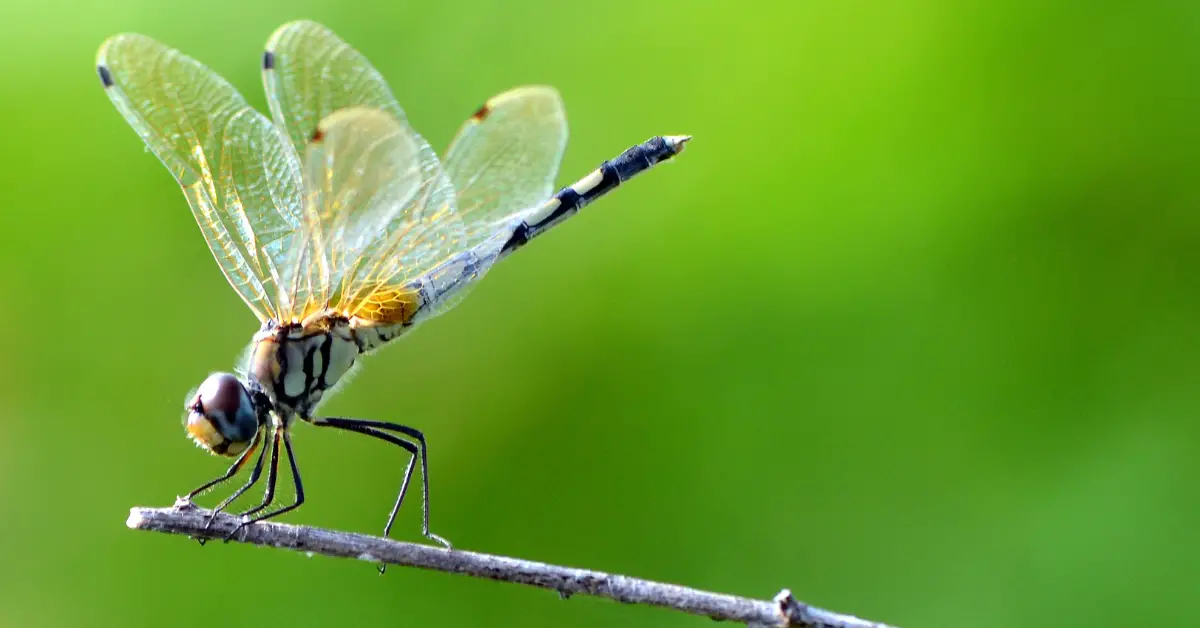Did you know that mosquitoes can quickly turn a pleasant summer evening into a maddening battle against itchy bites? As these blood-sucking pests thrive during the warm months, they can quickly become a nuisance, interrupting our outdoor activities and posing health risks. But fear not, for nature has provided a remarkable solution: dragonflies.
These beautiful insects serve as efficient and voracious mosquito predators, consuming hundreds of mosquitoes daily. By strategically incorporating specific plants into your yard, you can attract dragonflies and establish a natural defense against these bothersome pests.
In this comprehensive guide, we will explore the fascinating relationship between dragonflies and mosquitoes, discuss the scientific evidence supporting the benefits of dragonflies, and unveil the top plants that will invite these graceful hunters into your outdoor space.
Dragonflies and Mosquitoes: A Perfect Predator-Prey Balance
Dragonflies, often seen fluttering around wet areas abundant with flowers and insects, possess the remarkable ability to control mosquito populations effectively. Not only do they target the annoying insects that plague us during summer, but they also play a crucial role in curbing the spread of mosquito-borne diseases.

Scientific research has revealed that dragonflies can consume up to 15% of their body weight daily, consisting of mosquitoes, horseflies, termites, blackflies, and midges. These findings underscore the significant impact dragonflies can have on maintaining ecological balance and protecting human health. [1,2]
Experts have hailed dragonflies as the top predators in the insect world, ensuring a harmonious insect population in your yard. To harness the power of these natural mosquito exterminators, it is vital to cultivate an environment that attracts and sustains dragonflies. [3,4]
Must-Have Plants for Attracting Dragonflies
There are three plants known for their ability to entice dragonflies while simultaneously reducing mosquito populations.
1. Fragrant Water Lilies
Fragrant water lilies are a captivating aquatic plant known for their wide-open blooms, unique leaf structures, and radiant colors ranging from white to pink. Placing these plants in pots submerged approximately six inches below the water’s surface, near pools, streams, or ponds, creates an ideal habitat for dragonflies.
Above the glossy heart-shaped green pads, the fragrant water lilies proudly bloom, captivating both human observers and dragonflies alike. They have been proven to be effective in attracting dragonflies, making them an excellent addition to your mosquito control strategy. [5,6]

2. Swamp Milkweed
Swamp milkweed, a close relative of the well-known milkweed plant, boasts stunning white and pink flowers that return year after year. It not only entices butterflies, wasps, and bees but also acts as a beacon for dragonflies that prey on these species.
Flourishing in wetland areas, swamp milkweed can also thrive in moist clay soil with proper watering. It thrives when exposed to full sunlight, making it an excellent addition to your yard to attract dragonflies and reduce mosquito populations. [6,7]
3. Pickerelweed
The pickerelweed plant stands tall, reaching heights of up to three feet, adorned with elegant, heart-shaped leaves and a spike of deep blue flowers. With its unique blooming pattern from the bottom up, this emergent aquatic plant adds vibrancy and visual appeal to your garden throughout the scorching summer months.
By placing pickerelweed in pots submerged in water, akin to fragrant water lilies, you create an inviting environment for dragonflies. The flowers and leaves gracefully rise above the water while portions of the stem stretch below, beckoning dragonflies to visit and join the fight against mosquitoes. [8]

My Personal RX for Mosquito-Free & Bite-Proof Health
As the warmer months roll in, pesky mosquito bites can really put a damper on outdoor fun. Having dealt with these tiny annoyances myself, I’ve compiled a set of tried-and-true tips to stay healthy and avoid those itchy bites.
- Remove stagnant water sources, such as birdbaths or unused containers, to eliminate mosquito breeding grounds. Keep your yard well-maintained, trimming grass and shrubs regularly to reduce mosquito resting areas.
- Avoid outdoor activities during peak mosquito hours, typically dawn and dusk. Otherwise, wear protective clothing, such as long sleeves and pants, and apply mosquito repellents containing non-toxic ingredients.
- Install fine mesh screens on windows and doors to prevent mosquitoes from entering your home.
- As we turn our attention to the natural balance and wellness of our gardens, it’s important to remember that our bodies also require a balanced ecosystem to thrive. This can be achieved by providing it with all the essential nutrients it needs. Take my Men’s Core and Women’s Core Essential Supplements to boost your immune and overall well-being.
- Just as we can take control of our backyard ecosystems, so too can we take charge of our health and well-being. Watch a special screening of my movie “How to Become Your Own Health Hero.” With a little guidance and support, anything is possible – don’t miss this unique opportunity to learn how to become your own Health Hero!
Summer enjoyment shouldn’t be overshadowed by pesky mosquitoes. By harnessing the power of dragonflies, you can naturally control mosquito populations in your yard, creating a harmonious and bite-free outdoor space.
Remember, while bug sprays and insect-repellent candles offer temporary relief, establishing a sustainable and environmentally friendly mosquito control solution is best achieved by attracting natural predators. Embrace the synergy of nature and let dragonflies be your ultimate allies in the battle against mosquitoes.

Sources:
- Vatandoost, H. (2021). Dragonflies as an Important Aquatic Predator Insect and Their Potential for Control of Vectors of Different Diseases. Journal of Marine Science, 3(3). https://doi.org/10.30564/jms.v3i3.3121
- Ellis, M. R. (2013). Influence of dragonfly larvae on mosquito development and survival. Cary Institute of Ecosystem Studies. https://www.caryinstitute.org/sites/default/files/public/reprints/ellis_2013_REU.pdf
- Riyaz, M. (2021). Dragonflies: The apex predators of the insect world. Loyolacollege. https://www.academia.edu/49481867/Dragonflies_The_Apex_Predators_of_the_Insect_World
- Kaunisto, K., Roslin, T., Forbes, M. R., Morrill, A., Sääksjärvi, I. E., Puisto, A., Lilley, T. M., & Vesterinen, E. J. (2020). Threats from the air: Damselfly predation on diverse prey taxa. Journal of Animal Ecology, 89(6), 1365–1374. https://doi.org/10.1111/1365-2656.13184
- Fragrant Water Lily (Nymphaea odorata) Species Page. (n.d.). http://www.bio.brandeis.edu/fieldbio/Wildflowers_Kimonis_Kramer/PAGES/FRAGRANTWATERLILY_PAGE_FINAL.html
- Dvorak, B. (2023). Designing green roofs for dragonflies | Bruce Dvorak. Living Architecture Monitor. https://livingarchitecturemonitor.com/articles/designing-green-roofs-for-dragonflies-su23
- Baessler, L., & Baessler, L. (2021, February 15). Swamp Milkweed Info – Tips For Growing Swamp Milkweed Plants. Gardening Know How. https://www.gardeningknowhow.com/ornamental/flowers/milkweed/growing-swamp-milkweed-plants.htm
- Lady Bird Johnson Wildflower Center – The University of Texas at Austin. (n.d.). https://www.wildflower.org/plants/result.php?id_plant=POCO14




















